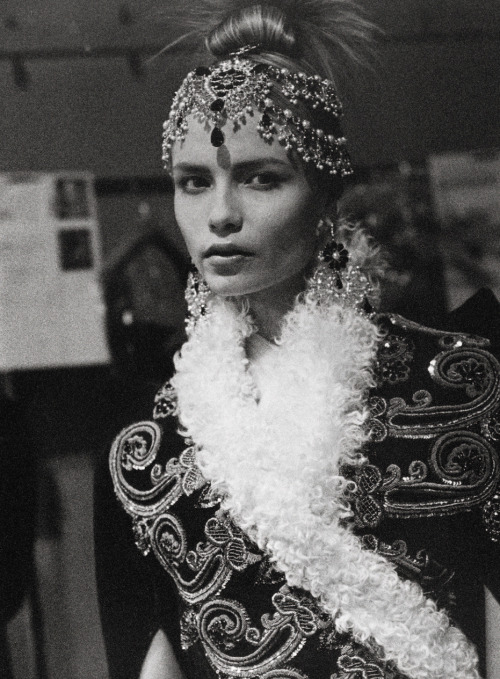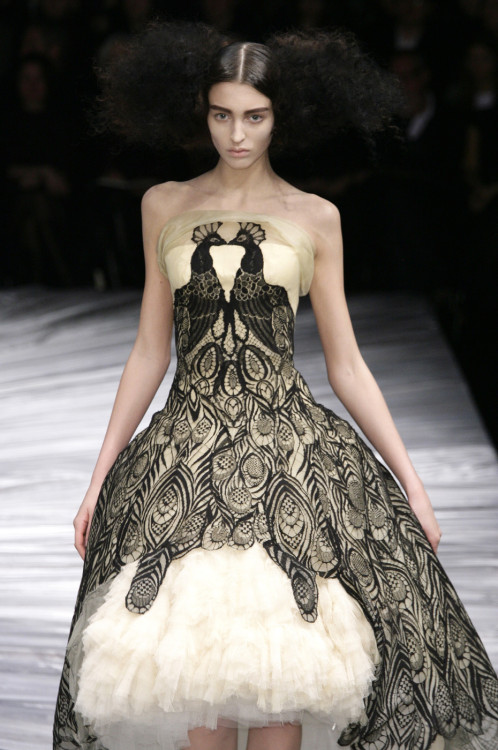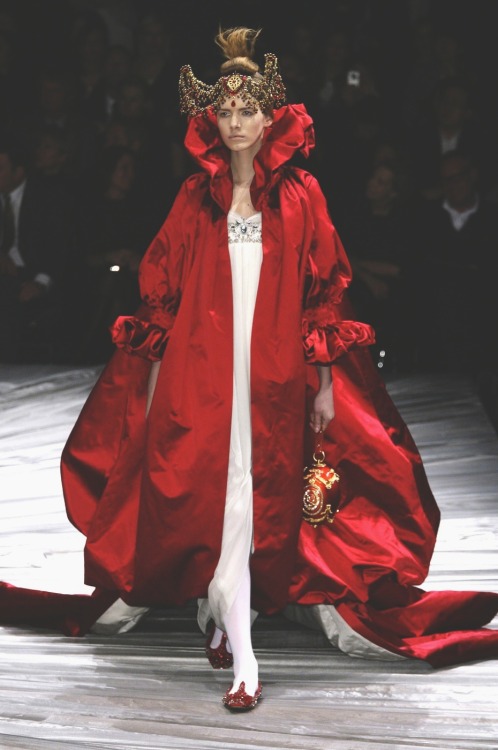For McQueen’s A/W 2008 presentation ‘The Girl
Who Lived in the Tree’ (which can be seen in full here), the designer decided
to use his imagination to create an unusual story behind the decadent
collection. Speaking of the show, he told of how he would look at the
600-year-old elm tree which stood in his garden and dream that there was a girl
dwelling inside it. The story behind this runway presentation would be of that
same girl fleeing the darkness of her tree in order to meet her Prince, get
married and become a Queen. Set to a soundtrack which combined Indian chants
with a classical rendition of ‘Smells like Teen Spirit’, the show was a
wonderful example of the designer’s childlike fascination with all things
magical and resulted in a series of crinolined princess wandering like nomads around the tulle-wrapped tree which stood centre-stage.
The collection itself was divided into two
halves, the first of which told the story of the girl who lived in the
darkness, made evident by an almost complete absence of colour. Ruffled white
shirts and severe tailcoats were combined with bushy, unkempt hair to give the
impression of a character that desired elegance but never got it quite right.
There was military detailing in the rope fastenings of the coats, and a
Siberian influence seemed to reign supreme in a series of oversized knits,
shaggy fur coats and black cardigans embellished with starbusts of gold. One
particularly impressive dress saw a cream base overshadowed by two enormous
black birds whose lace wings spanned the length and breadth of the dress,
coming together at the hemline of the dress where the makeshift wings draped
elegantly over the tulle underskirt and flapped elegantly as the model walked.
This dress marked the end of the darkness and it
was Tanya Dziahileva (one of McQueen’s favourite models) that ushered in the
more regal half of the show in a glorious red military jacket with gold rope
fastenings, teamed with a white chiffon skirt and lashings of excessive beaded
jewellery. It was in this half of the show that McQueen’s visit to India began
to inspire the results – the heeled boots of the first section were replaced by
jewelled moccasins and silk skirts which draped across the body like a sari.
McQueen’s patriotism made an appearance in the form of an exquisite Union Jack
dress which was ruched almost beyond recognition. The fabric was emblazoned
with the iconic image of the Queen’s head and its hemline failed to contain the
froth of the white underskirt that lay beneath.
A wash of royal blue and white began to dominate
the new colour palette, always broken up with gold crowns, intricate beaded
headbands and heavy chandelier earrings. The diamond chokers and exaggerated silhouettes
were fit for a Queen – a Queen that made an appearance for the show’s finale in
a dramatically oversized red cloak. Ruched in several places and teamed with a
crown headpiece dripping with rubies, the model skulked along the runway with her
blood-red sceptre and closed the show in spectacular fashion. The fact that
this fantasy of unbridled extravagance came from McQueen’s mind is another
reminder that fashion is more than just clothing – it’s more than practicality.
At its best, fashion is a fantasy with the ability to transport us to another
world and, at a time in which the world’s economy was crippled by recession,
McQueen succeeded in this mission.





No comments:
Post a Comment